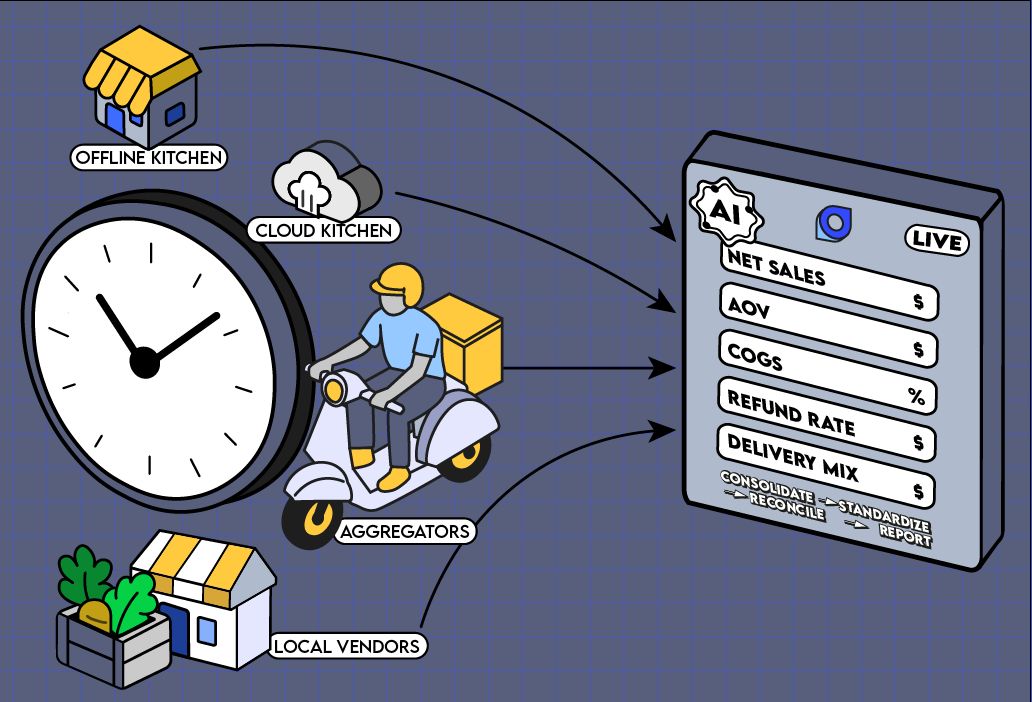The “Quick” in Quick Service Restaurants (QSRs) isn’t just for food delivery, but also for backend operations. Orders move fast, customers move fast, and data moves even faster.
But for most QSR finance teams, key finance functions like reporting haven’t caught up. Daily sales numbers arrive late. Store-level performance remains unclear. Delivery partner payouts don’t match. And leaders tend to make delayed decisions with limited visibility.
AI and automation empower QSR finance teams with clean, accurate data, real-time visibility, and automated reporting for reducing errors, detecting anomalies, accelerating decision-making, and helping leaders protect margins in a high-volume, low-margin industry.
The Real Reporting Challenge in QSRs
QSRs handle thousands of transactions every day across multiple channels: dine-in, takeaway, apps, aggregators, and drive-thrus. Each store uses its own POS system, and payments can be made with cash, cards, wallets, or UPI. Promotions change daily, refunds and cancellations vary by partner, and a disjointed tech stack, where data sits in different systems, makes it even harder to accurately consolidate and reconcile data.
The QSR problem: data sits everywhere, and moves faster than spreadsheets can keep up.
Why data sits everywhere and moves faster than spreadsheets in QSR
QSR operators generate truth at the edge every minute. Orders, payouts, refunds, promos, and GRNs update continuously across systems, and finance teams must reconcile that motion in near real time. Spreadsheets cannot keep pace.
Where the data sits
- Many sources by design: Each store runs its own POS/KDS while orders flow from delivery apps, brand apps, kiosks, QR tables, and drive-thru systems. Payments land via cash, cards, wallets/UPI, and COD with next-day banking.
- Franchise variability: Different POS versions, tax codes, and Chart of Accounts (COA) mappings fragment otherwise “standard” reports.
- Item complexity: Combos, add-ons, and modifiers multiply lines; one burger can spawn several SKU rows (bun, patty, extra cheese, meal upgrade).
- Disjointed Tech Stack: Data sits across multiple systems, including Order Management Systems, Payment Gateways, ERP, and more. Each system captures different aspects of daily operations, creating a fragmented data landscape
- Fragmented Aggregator Platforms: Aggregator platforms like Swiggy and Zomato often lack centralized logins for multiple kitchens and have unstable APIs. Each kitchen needs separate logins, making data fetching and reconciliation complex for larger brands.
Why does the data move faster than spreadsheets
- High-velocity tickets: Stores process thousands of orders per day; metrics shift minute to minute.
- Short shelf-life decisions: Prep, staffing, and pricing demand same-day action; yesterday’s file arrives too late.
- Data lands at different times: payouts come a day or two later, refunds and cancellations arrive after that, and promos can change records. So, today’s numbers include yesterday’s events.
- Schema drift: Menus change, Limited Time Offers (LTOs) launch, taxes update, partner exports evolve, and eventually Excel formulas break silently.
What makes this uniquely QSR
- More tickets, smaller baskets: Compared with casual dining, QSRs reconcile many small checks with modifiers—granularity raises error risk.
- Day-part volatility: Breakfast, lunch, tea-time, and late-night spikes require intra-day refresh (15–60 minutes), not end-of-day files.
- Perishables & yield pressure: Delays translate into real spoilage and margin loss, not just slower insight.
- Third-party dependency: Delivery partners add commissions, contra-promos, and service-fee logic that changes often and settles on different clocks.
Where spreadsheets crack
- Latency: Manual downloads and VLOOKUP chains cannot meet hourly SLAs across 50–500 stores.
- Volume & concurrency: Row limits, file locks, and fragile macros falter under millions of lines and multi-user edits.
- Late-arriving data: Excel doesn’t track changes or merge by unique keys, so back-dated refunds create duplicates and gaps.
- Auditability: Version control, lineage, and approval trails remain ad hoc and indefensible at scale.
In short, financial reporting breaks because data comes in from too many sources, too fast, and in too many formats for manual processes to keep up. Only smart, automated, governed reporting can keep pace with the QSR finance function reality.
Why AI-Automated Reporting is the Way Forward for QSRs
QSRs live in minutes, not months, and AI Automation can deliver the speed, accuracy, and insights needed by CFOs and finance leaders in this industry.
AI-powered automation platforms like Bluecopa make QSR reporting reliable, timely, and scalable by standardizing inputs, preventing duplicates, and surfacing issues before they hit the P&L.
- Clean, consolidated data: It maps all data sources and formats like POS, delivery, payments, vendor invoices, inventory, and more into a unified, single source of truth. Store IDs, SKUs, tenders, and taxes standardize automatically, with lineage so every number is auditable.
- Automated anomaly detection & resolution: ML flags outliers in near real time, refund spikes, mismatched commissions, promo misuse, cash over/short, abnormal COGS. It suggests likely root causes (store, item, channel, partner), opens tickets with evidence, and tracks SLA-based closure. Policy-aware thresholds adapt by store, day-part, and season to minimize noise.
- Real-time visibility & proactive insights: Dashboards refresh every 15–60 minutes for net sales, AOV, COGS value, labor value, channel mix, refunds, and delivery partner scorecards. Exception queues show only what needs action today: unsettled payouts, aged GR/IR, and tax variances. Short-horizon forecasts and narrative summaries explain what changed and why.
One version of truth across entities, earlier detection of leakage, better revenue forecasting, and the ability to make strategic decisions like adding stores without adding spreadsheet headcount.
In short, AI-powered reporting gives finance clean data, fewer errors, automated controls, and real-time insight, so leaders act faster with confidence.
An intelligent automation platform like Bluecopa helps QSRs report and forecast better with complete real-time visibility into sales, payouts, store performance, and margins
See how Bluecopa can power your QSR’s next phase of growth.
*This article is refined by AI




.jpg)